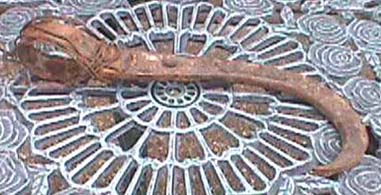
cant hook (artifact #13)

A cant hook (cant dog or peavey) is a tool used mostly in times past for rolling and loading logs onto a horse-drawn wagon. It gives a man the ability to handle the tremendous weight found in green logs. Most logs are cut and taken to the mill soon after felling, they are full of water and quite heavy.
Two men can quickly load a large log onto a wagon by working together, each with his own cant hook. One will hold while his partner sets up a new bite on the log. Loading the log is accomplished by setting up two large poles to form a ramp. The poles, set on the ground near each end of the log, are parallel and leaned onto the wagon. This makes an incline on which to roll the log. Due to the weight of the log, the ramp tends not to move. If a person selects the site, sometimes it is possible to have the wagon slightly lower so that the logs can be rolled at a lower incline, making the work as easy as possible. One very quickly learns by observation to take advantage of what nature provides.

Looking at the picture you can see the tool gives a two or three point contact with the log. The point on the tool is very sharp and bites into the log with a firm grip. One person can load the logs alone, which might be a bit dangerous but was commonly done. Working alone would be from necessity.
The logs would be skidded to a “landing” site for loading, hauled by a team of horses on a wagon to a mill for perhaps miles. Unloading was usually easier in the Ozarks, as a mill was usually below a hill. The logs were rolled off the wagon with a thunderous whump, thump and a crunch against the logs previously unloaded. At the mill site, in front of the mill’s carriage, you usually find a flat area where logs are carefully lined up for loading onto the carriage and sawed into lumber.
This particular broken cant hook seems out of place on either my dad’s or my
grandfather’s timberlands. Perhaps it was found as they both had good tools and
kept them in an excellent state of repair. In any case, this broken cant hook was
repaired on the spot with what appears to be bailing wire. This would have been a
temporary fix and only for the day while in the woods. Dad left repairs to the local
blacksmith. Why Dad held on to this cant hook is a mystery to me, especially since
it is broken, without a handle, and with the bailing wire repair. This particular one is
a smaller, lightweight version and may have held some appeal. The hooks on some
are larger, some with a more pronounced right-angle hook. The version would
depend upon the size of the timber being worked and personal choice. One size is
mostly adequate for all timber in NW Arkansas.
Charles Doyle 3/8/03